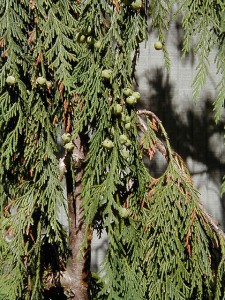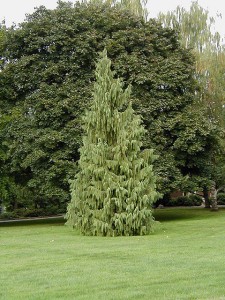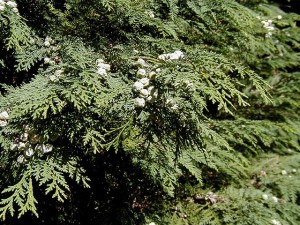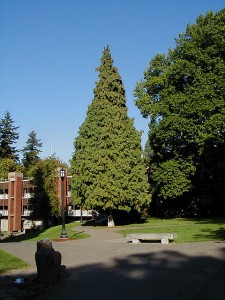Scientific Name: Chamaecyparis
Genus: Chamaecyparis
Family: Cupressaceae
Common names for trees in this genus can be misleading. What’s called a “Port-Orford-cedar” isn’t really a cedar because it isn’t in the genus Cedrus. In fact, it’s not even closely related to the true cedars, which are in the Pine family (Pinaceae).
These trees are called “false cypresses” because they are in the Cypress family (Cupressaceae) but not in the true cypress genus, Cupressus. The common names are written with hyphens to indicate that they are not true cedars or cypresses.
Alaska-cedar, Nootka-cypress
Scientific name: Chamaecyparis nootkatensis
 This tree is an evergreen native from Alaska to northern Oregon. It has dark green foliage with branches that droop enough to give it a wilted appearance. Sometimes difficult to distinguish from the Port-Orford-cedar, the Alaska-cedar has no white Xs on the underside of the scales. Native Americans prized the wood of this cedar for canoe paddles, and is still used today for poles, paddles, and boat construction. The Japanese prize this wood highly.
This tree is an evergreen native from Alaska to northern Oregon. It has dark green foliage with branches that droop enough to give it a wilted appearance. Sometimes difficult to distinguish from the Port-Orford-cedar, the Alaska-cedar has no white Xs on the underside of the scales. Native Americans prized the wood of this cedar for canoe paddles, and is still used today for poles, paddles, and boat construction. The Japanese prize this wood highly.
View tree page and map.Port-Orford-cedar
Scientific name: Chamaecyparis lawsoniana
 This tree has small, bluish, rounded cones. Foliage, which is feathery, varies in color from yellow-green to blue-green depending on the variety. Port-Orford-cedars are native to the Siskiyou Mountains of southwest Oregon and northwest California. The wood of this tree is highly prized in Japan. This species is being decimated both in the wild and in cultivation by a root-rot.
This tree has small, bluish, rounded cones. Foliage, which is feathery, varies in color from yellow-green to blue-green depending on the variety. Port-Orford-cedars are native to the Siskiyou Mountains of southwest Oregon and northwest California. The wood of this tree is highly prized in Japan. This species is being decimated both in the wild and in cultivation by a root-rot.
View tree page and map.